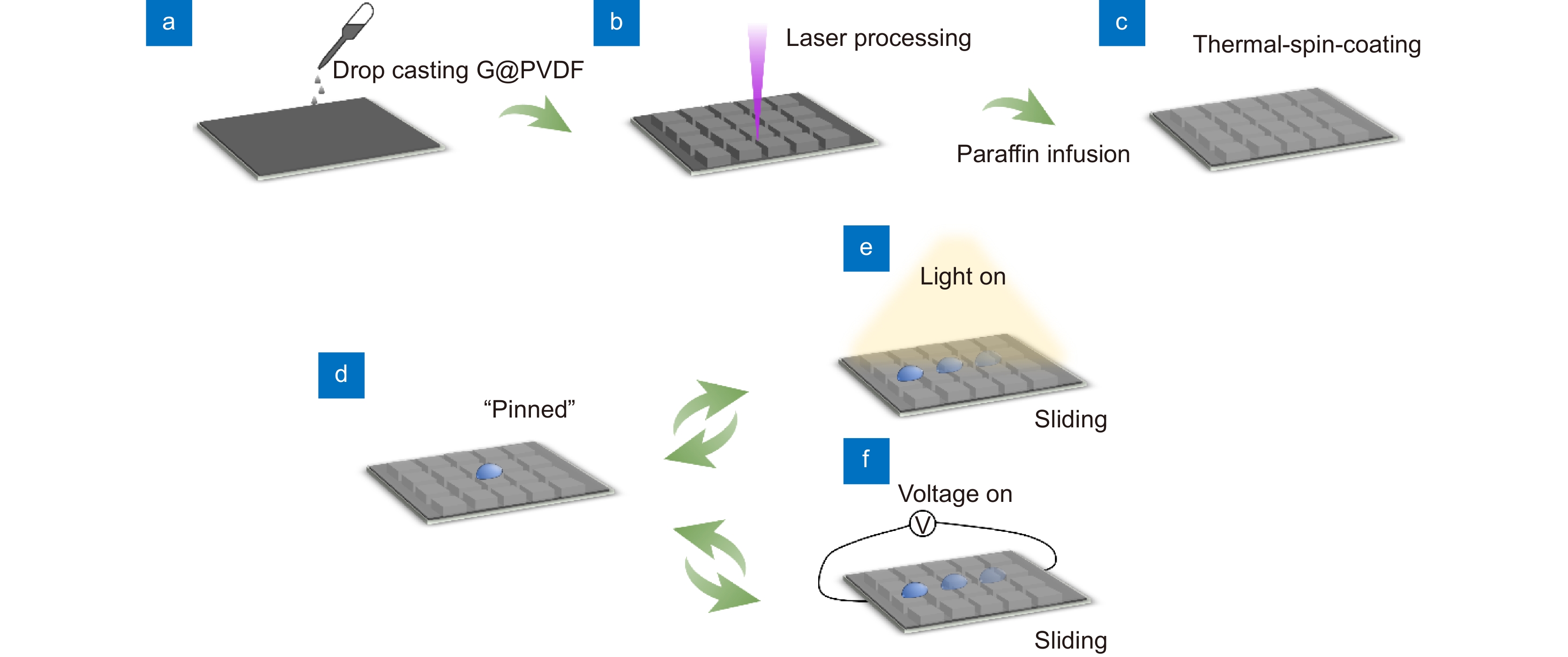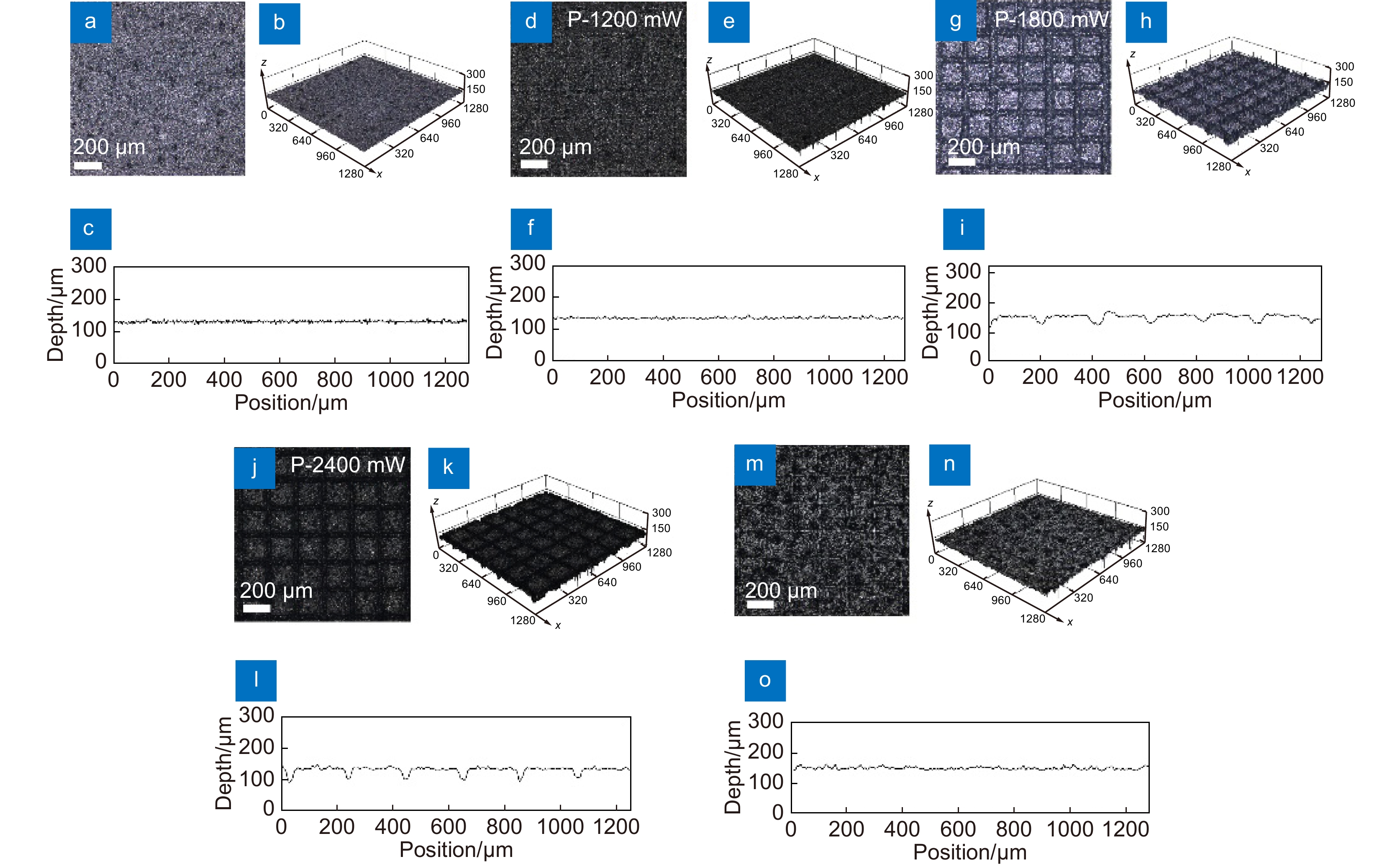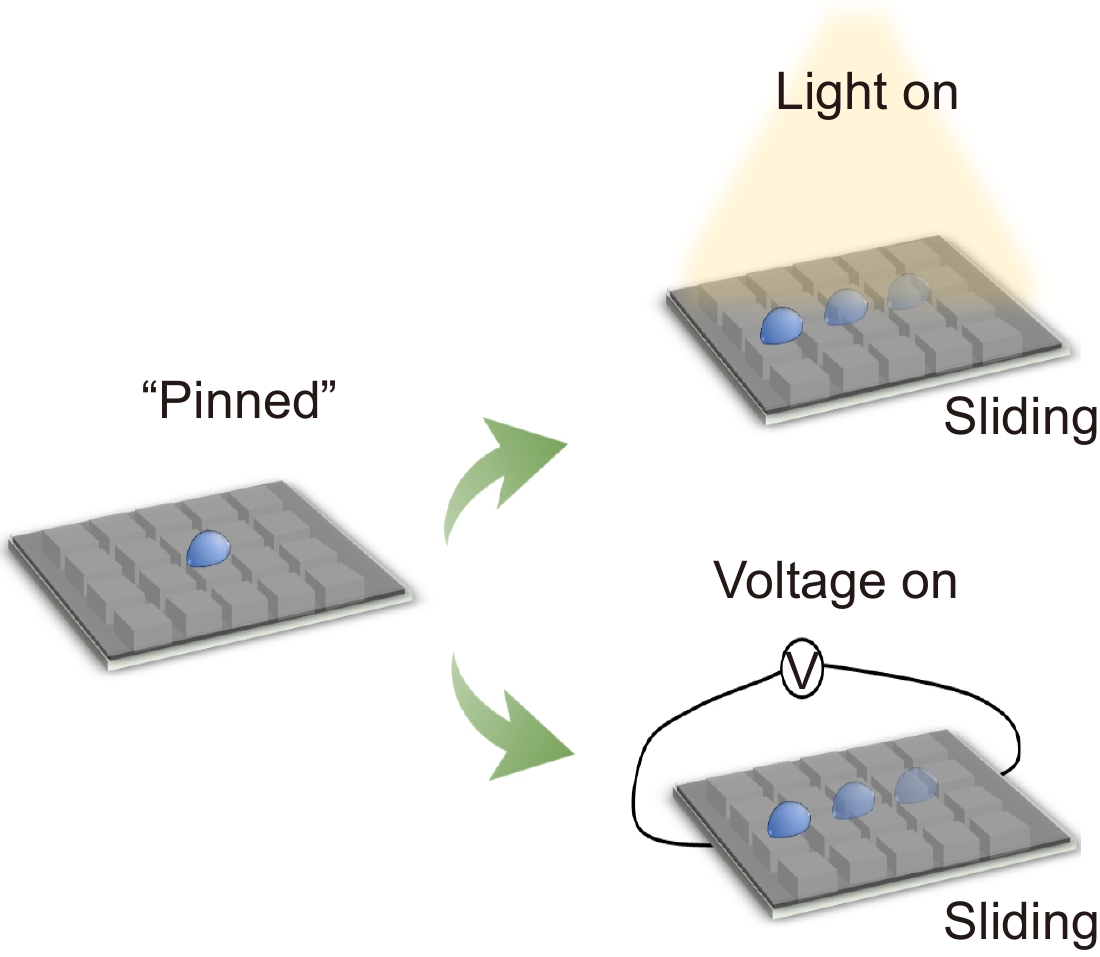Laser fabrication of light/voltage-responsive slippery liquid-infused porous substrate (SLIPS)
-
摘要
受到自然界的猪笼草启发,超滑表面受到了许多关注。本文通过激光加工技术在石墨烯和聚偏氟乙烯的复合材料表面(G@PVDF)进行烧蚀,采用热旋涂法将石蜡材料均匀地填充于网格状沟槽内部。利用共聚焦显微镜(CLSM)和扫描电子显微镜(SEM)表征激光加工后沟槽的形貌与深度,利用UV3600以及红外热成像仪测试样品的光吸收以及光热特性。当复合材料表面未受到强光照射时,液滴“钉”在表面;由于石墨烯具有优异的光热转换能力,当复合材料表面受到强光照射时,复合材料表面吸收光能并产生热量使石蜡融化,液滴与表面由粗糙的气/液/固状态转变为光滑的气/液/润滑剂/固状态,液滴可在倾斜角约10°的状态滑动且无残留。另一方面,通过外界电压也能同样控制液滴的行为。研究结果对于智能化操控液滴有着重要的意义。
Abstract
Inspired by the nepenthes in nature, slippery liquid-infused porous substrates (SLIPS) have attracted extensive research attentions. In this work, a graphene @ polyvinylidene fluoride (G@PVDF) composite substrate was ablated by a laser technology. Then paraffin is uniformly filled in the grooves by a thermal spin-coating method. A confocal laser scanning microscope and a scanning electron microscope were used to characterize the surface morphology and depth of the grooves. UV3600 and Infrared thermal imagers were used to test the absorption and photothermal characteristics of the samples. The droplet is "pinned" on the surface without light irradiation. Since graphene has excellent photothermal conversion capability, the photothermal conversion happens upon light irradiation. The temperature is high enough to melt the paraffin, the interface state changes from the friction gas-liquid-solid interface to a smooth gas-liquid-lubricant-solid interface. The droplet can slide at an inclination angle of about 10° without leaving any residues. In addition, the droplet sliding can be controlled by an external voltage. This work shows potentials in manipulating the behavior of droplets.
-
Key words:
- laser fabrication /
- graphene /
- slippery surface /
- wettability
-
Overview
Overview: A slippery liquid-infused porous surface (SLIPS) inspired by nepenthes plays a significant effect in anti-adhesion, drag reduction, and droplet/bubble transportation etc. The SLIPS is constructed by infusing low surface energy lubricating liquid into the porous substrate. On the one hand, the porous substrate can firmly lock the lubricating liquid within the porous network. On the other hand, the lubricating liquid can dynamically flow in the porous substrate. Therefore, SLIPS shows the advantage of repelling complex liquids (blood, crude oil, etc.), self-healing, and high-pressure resistance, etc. For the intelligent responsive SLIPS, stimulus-response substances are added to the porous substrate, and then the surface wettability can be switched by external stimuli such as electric field, light, etc. Since droplets can be manipulated more precisely, the intelligent responsive SLIPS has broader prospects. In this study, graphene was added to the PVDF solution and thermal drying was performed to form a membrane. This leads to the obvious improvement of light absorption and photothermal conversion compared to that of the membrane without graphene. Then, a UV laser was used to ablate the graphene/polyvinylidene fluoride (G@PVDF) composite film surface for fabricating the grid-like grooves. Then paraffin was poured into the grooves by a thermal spin-coating method to well fill the grooves. In this process, the paraffin was melted or solidified by switching ON and OFF states of the light source, realizing the non-contact controllable manipulation of the droplet. When there is no light, there is a solid-liquid interface between the droplet and surface, and the droplet is "pinned" on the surface. As graphene has excellent light-to-heat conversion ability, the heat is enough to make the phase-change material paraffin melt when the light is on. The interface state between the water droplet and surface changes from the friction gas-liquid-solid interface to a smooth gas-liquid-lubricant-solid interface. The droplet can easily slide at an inclination angle of about 10° without leaving any residues. Alternatively, we employed laser-induced graphene (LIG) on a polyimide film as a heat source, and attached the SLIPS on the LIG. By applying voltage on LIG, it is also able to dynamically control the states of droplets. This kind of light/voltage-controlled SLIPS to control droplet behaviors is of great significance in anti-adhesion, biomedical, microfluidic devices, and other fields.
-

-
-
参考文献
[1] Chen H W, Zhang P F, Zhang L W, et al. Continuous directional water transport on the peristome surface of Nepenthes alata[J]. Nature, 2016, 532(7597): 85−89. doi: 10.1038/nature17189
[2] Li C X, Yu C L, Zhou S, et al. Liquid harvesting and transport on multiscaled curvatures[J]. Proc Natl Acad Sci USA, 2020, 117(38): 23436−23442. doi: 10.1073/pnas.2011935117
[3] Yao X, Hu Y H, Grinthal A, et al. Adaptive fluid-infused porous films with tunable transparency and wettability[J]. Nat Mater, 2013, 12(6): 529−534. doi: 10.1038/nmat3598
[4] Lv P, Zhang Y L, Han D D, et al. Directional droplet transport on functional surfaces with superwettabilities[J]. Adv Mater Interf, 2021, 8(12): 2100043. doi: 10.1002/admi.202100043
[5] Zhang X X, Sun L Y, Wang Y, et al. Multibioinspired slippery surfaces with wettable bump arrays for droplets pumping[J]. Proc Natl Acad Sci USA, 2019, 116(42): 20863−20868. doi: 10.1073/pnas.1912467116
[6] Lv X D, Jiao Y L, Wu S Z, et al. Anisotropic sliding of underwater bubbles on microgrooved slippery surfaces by one-step femtosecond laser scanning[J]. ACS Appl Mater Interfaces, 2019, 11(22): 20574−20580. doi: 10.1021/acsami.9b06849
[7] Wong T S, Kang S H, Tang S K Y, et al. Bioinspired self-repairing slippery surfaces with pressure-stable omniphobicity[J]. Nature, 2011, 477(7365): 443−447. doi: 10.1038/nature10447
[8] Chen C, Huang Z C, Jiao Y L, et al. In situ reversible control between sliding and pinning for diverse liquids under ultra-low voltage[J]. ACS Nano, 2019, 13(5): 5742−5752. doi: 10.1021/acsnano.9b01180
[9] Fang Y, Liang J, Bai X, et al. Magnetically controllable isotropic/anisotropic slippery surface for flexible droplet manipulation[J]. Langmuir, 2020, 36(50): 15403−15409. doi: 10.1021/acs.langmuir.0c03008
[10] Wang J, Gao W, Zhang H, et al. Programmable wettability on photocontrolled graphene film[J]. Sci Adv, 2018, 4(9): eaat7392. doi: 10.1126/sciadv.aat7392
[11] Han B, Zhang Y L, Chen Q D, et al. Carbon-based photothermal actuators[J]. Adv Funct Mater, 2018, 28(40): 1802235. doi: 10.1002/adfm.201802235
[12] Zhang Y L, Li J C, Zhou H, et al. Electro-responsive actuators based on graphene[J]. Innovation, 2021, 2(4): 100168.
[13] Wang J N, Liu Y Q, Zhang Y L, et al. Wearable superhydrophobic elastomer skin with switchable wettability[J]. Adv Funct Mater, 2018, 28(23): 1800625. doi: 10.1002/adfm.201800625
[14] Huang Z C, Chen C, Wang X H, et al. Light-driven locomotion of underwater bubbles on ultrarobust paraffin-impregnated laser-ablated Fe3O4-doped slippery surfaces[J]. ACS Appl Mater Interfaces, 2021, 13(7): 9272−9280. doi: 10.1021/acsami.0c22717
[15] Jiao Y L, Lv X D, Zhang Y Y, et al. Pitcher plant-bioinspired bubble slippery surface fabricated by femtosecond laser for buoyancy-driven bubble self-transport and efficient gas capture[J]. Nanoscale, 2019, 11(3): 1370−1378. doi: 10.1039/C8NR09348B
[16] Hu Z, Huang X J, Yang Z W, et al. Reversible 3D optical data storage and information encryption in photo-modulated transparent glass medium[J]. Light Sci Appl, 2021, 10(1): 140. doi: 10.1038/s41377-021-00581-y
[17] Liu H G, Lin W X, Hong M H. Hybrid laser precision engineering of transparent hard materials: challenges, solutions and applications[J]. Light Sci Appl, 2021, 10(1): 162. doi: 10.1038/s41377-021-00596-5
[18] Li Z Z, Wang L, Fan H, et al. O-FIB: far-field-induced near-field breakdown for direct nanowriting in an atmospheric environment[J]. Light Sci Appl, 2020, 9(1): 41. doi: 10.1038/s41377-020-0275-2
[19] Sun Y L, Dong W F, Yang R Z, et al. Dynamically tunable protein microlenses[J]. Angew Chem Int Ed, 2012, 51(7): 1558−1562. doi: 10.1002/anie.201105925
[20] 朱裔良, 谢小柱, 黄庆澎, 等. 飞秒绿激光加工镁合金的研究[J]. 光电工程, 2019, 46(8): 180672.
Zhu Y L, Xie X Z, Huang Q P, et al. Femtosecond green laser processing of magnesium alloy[J]. Opto-Electron Eng, 2019, 46(8): 180672.
[21] Jia Y C, Wang S X, Chen F. Femtosecond laser direct writing of flexibly configured waveguide geometries in optical crystals: fabrication and application[J]. Opto-Electron Adv, 2020, 3(10): 190042. doi: 10.29026/oea.2020.190042
[22] Livakas N, Skoulas E, Stratakis E. Omnidirectional iridescence via cylindrically-polarized femtosecond laser processing[J]. Opto-Electron Adv, 2020, 3(5): 190035. doi: 10.29026/oea.2020.190035
[23] Wan Z F, Chen X, Gu M. Laser scribed graphene for supercapacitors[J]. Opto-Electron Adv, 2021, 4(7): 200079. doi: 10.29026/oea.2021.200079
[24] Zhao Y Z, Su Y L, Hou X Y, et al. Directional sliding of water: biomimetic snake scale surfaces[J]. Opto-Electron Adv, 2021, 4(4): 210008. doi: 10.29026/oea.2021.210008
[25] Zhao Y, Yang Y M, Sun H B. Nonlinear meta-optics towards applications[J]. PhotoniX, 2021, 2(1): 3. doi: 10.1186/s43074-021-00025-1
[26] Wang H, Zhang Y L, Han D D, et al. Laser fabrication of modular superhydrophobic chips for reconfigurable assembly and self-propelled droplet manipulation[J]. PhotoniX, 2021, 2(1): 17. doi: 10.1186/s43074-021-00033-1
[27] Fang H H, Ding R, Lu S Y, et al. Distributed feedback lasers based on thiophene/phenylene Co-oligomer single crystals[J]. Adv Funct Mater, 2012, 22(1): 33−38. doi: 10.1002/adfm.201101467
[28] Jin Y, Feng J, Zhang X L, et al. Solving efficiency-stability tradeoff in top-emitting organic light-emitting devices by employing periodically corrugated metallic cathode[J]. Adv Mater, 2012, 24(9): 1187−1191. doi: 10.1002/adma.201103397
[29] 聂世琳, 管迎春. 紫外激光器及其在微加工中的应用[J]. 光电工程, 2017, 44(12): 1169−1179.
Nie S L, Guan Y C. Review of UV laser and its applications in micromachining[J]. Opto-Electron Eng, 2017, 44(12): 1169−1179.
[30] 杨焕, 曹宇, 李峰平, 等. 激光制备超疏水表面研究进展[J]. 光电工程, 2017, 44(12): 1160−1168.
Yang H, Cao Y, Li F P, et al. Research progress in superhydrophobic surfaces fabricated by laser[J]. Opto-Electron Eng, 2017, 44(12): 1160−1168.
[31] Zhang C Y, Zhou W, Geng D, et al. Laser direct writing and characterizations of flexible piezoresistive sensors with microstructures[J]. Opto-Electron Adv, 2021, 4(4): 200061.
[32] Bi Y G, Feng J, Li Y F, et al. Broadband light extraction from white organic light-emitting devices by employing corrugated metallic electrodes with dual periodicity[J]. Adv Mater, 2013, 25(48): 6969−6974. doi: 10.1002/adma.201302367
[33] Liu Y S, Feng J, Ou X L, et al. Ultrasmooth, highly conductive and transparent PEDOT: PSS/silver nanowire composite electrode for flexible organic light-emitting devices[J]. Org Electron, 2016, 31: 247−252. doi: 10.1016/j.orgel.2016.01.014
[34] 矫知真, 李纪超, 陈招弟, 等. 激光加工减反射表面研究进展[J]. 中国激光, 2021, 48(2): 0202011. doi: 10.3788/CJL202148.0202011
Jiao Z Z, Li J C, Chen Z D, et al. Research progress on laser processing of antireflection surfaces[J]. Chin J Lasers, 2021, 48(2): 0202011. doi: 10.3788/CJL202148.0202011
-
访问统计


 E-mail Alert
E-mail Alert RSS
RSS

 下载:
下载:










